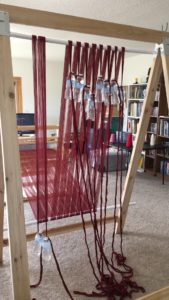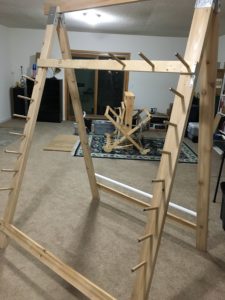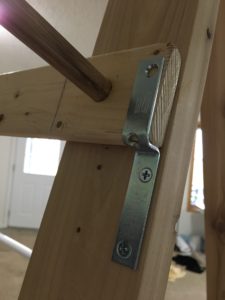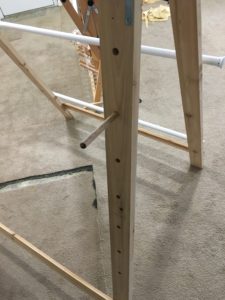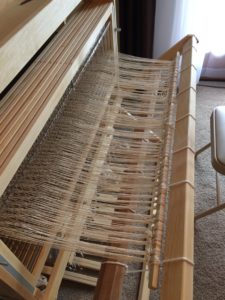The new fibers for weaving project #4 arrived today!
The goal for this experiment:
- Garment-weight cloth
- Fill the full-width of my 20-dent reed (had to order more heddles)
- Silk warp and wool weft
- Unbalanced twill
 I ordered silk and wool from Halcyon Yarn. I ordered a white 2/30 silk for the warp and a “French Blue” 2/20 wool for the weft.
I ordered silk and wool from Halcyon Yarn. I ordered a white 2/30 silk for the warp and a “French Blue” 2/20 wool for the weft.
I’m only going to weave a couple of yards for this experiment. It’ll be enough to do something small, like maybe a hood to wear with my cotehardies.
With the silk being finer than the wool, the cloth will be more wool-like than silk-like.
This one will still be a twill. I think I’d like to do an unbalanced twill this time. That way I could have either side of the hood be a little different color.
Planning the Warp
With this experiment, I had to order specific fibers instead of digging in to my stash of fibers.
I also had to do the math to figure out exactly how much fiber to order.
I pulled out my weaving books to find a formula for planning the amount of fiber.
My reeds are about 37″ wide. To be safe, I assume I can use 36″ of it. Using my 20-dent reed at 2-ends-per-dent across the 36″ equals 1440 ends.
20 x 36 x 2 = 1440 (had to order more heddles with the fiber)
- If I plan two yards of a finished woven length, that is 72″
- Assume approximately 5% shrinkage: ~4″
- Assume approximately 10% takeup: ~7″
- That equals approximately 83 inches of warp length to get to the finished woven length
- Assume approximately a yard of waste (I’m getting better at waste but I assumed a yard for my math)
- Now I’m up to 119″ (3.3 yards) of measured warp (and I can do a 3.3 yard path on my warping frame)
3.3 yards warp length x 1440 warp ends = 4752 yards of warp fiber.
The silk I picked out has 7200 yards per pound. I need 0.63 pounds. Based on how the silk is sold, I had to buy a full pound cone.
Planning the Weft
I’m planning on a 36″ wide cloth. Of course, there is likely to be some draw-in but I need to plan for getting better at weaving and draw-in being minimized as I work on these projects. So, assume I can create that full 36″ width.
Based on information at the website, I can get about 40 shots per inch of the wool.
36 x 40 = 1440″ of fiber per inch of woven cloth
Multiply that by the project length + shrinkage and divide by 36 to get the number of yards of fiber I need for the weft.
Result is 3040 yards.
The weft I picked out is 5600 yards/pound.
Again, I had to bought a full pound of the weft fiber.
I love this adventure!



















